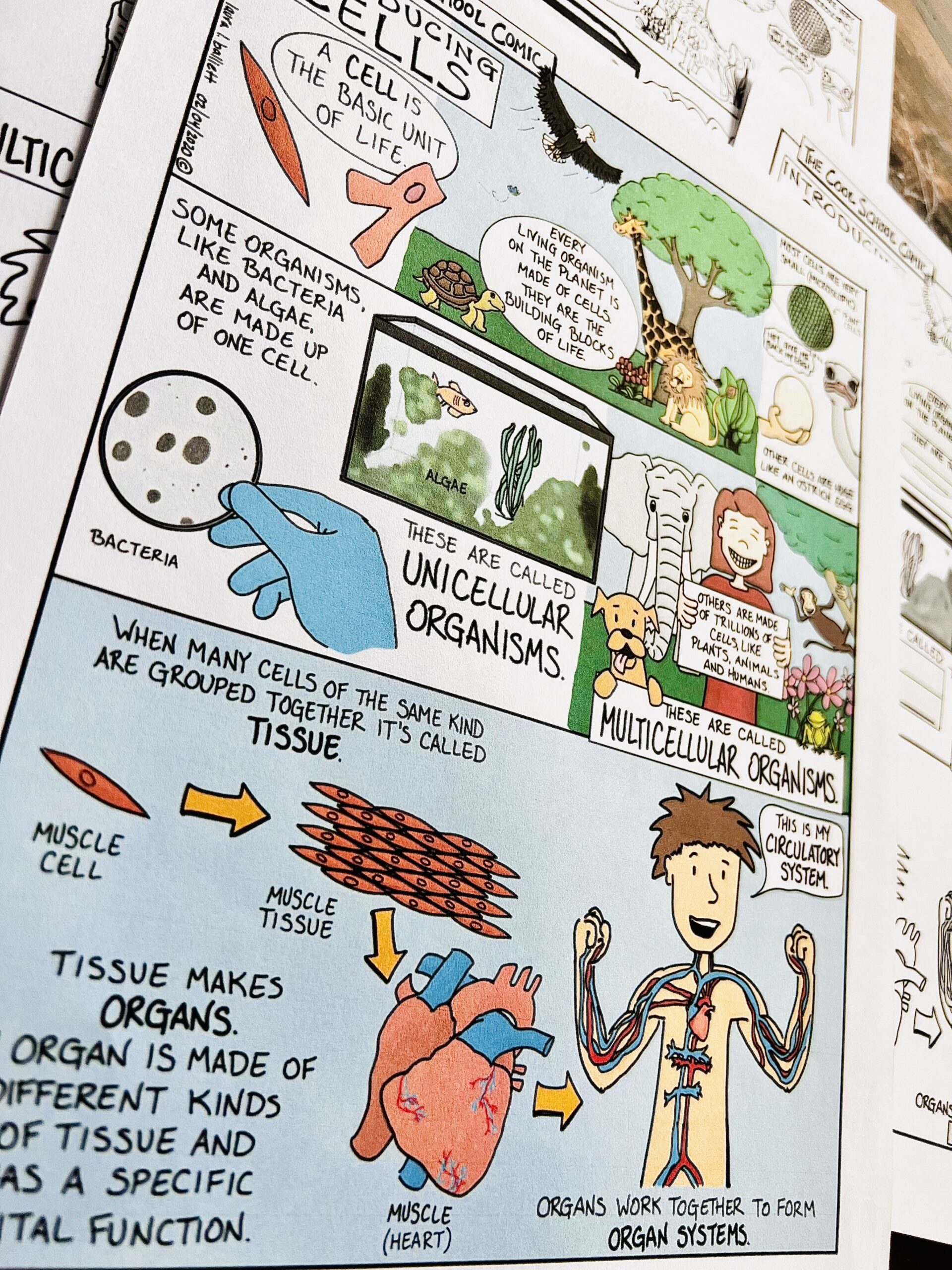Blog
Before the Big Plant and Animal Cell Project

Before the Big Plant and Animal Cell Project
The big plant and animal cell project is a yearly tradition with my sixth grade students. They have seen their siblings complete the project using various household items like candy and noodles. Now, they are in middle school science. Almost as if it is a right of passage, it is their turn to create a plant or animal cell model.
Before they can embark on this coveted cell project, they must have a foundational understanding of cells and their parts.
That’s where Cool School Comics comes in to save the day.


Basics First, Cell Project Second
Begin by explaining what cells are and why they are important. Use simple language and relatable examples to convey the idea that all living things are made up of cells.
When teaching sixth-grade students about cells, it’s important to focus on basic facts that provide a foundational understanding. Here are some essential facts about cells that sixth graders should know:
- Definition of a Cell: A cell is the basic building block of all living organisms. All living things are made up of one or more cells.
- Types of Cells: There are two main types of cells: plant cells and animal cells. Plant cells have a cell wall and chloroplasts, while animal cells do not.
- Cell Structure: Cells have various parts called organelles, including the cell membrane, nucleus, cytoplasm, and mitochondria.

The Difference Between Plant and Animal Cells
One of the main components of every cell project is to differentiate between plant and animal cells. While they have many similar parts, knowing the key differences is a huge chunk of this sixth-grade cell unit.
Utilize diagrams, charts, and models to visually represent plant and animal cells. These visual aids help students understand the structures and differences.

Additional Supplementals
In my middle school classroom, I like to use doodle notes to help keep my students engaged while we learn about new content. Students glue the page into their interactive science notebooks and create their own colorful notes.
They love this activity because it turns their science notebooks into comic books.

Maintaining the Comic Style
When I drew the cell diagrams for this lesson, I tried to remain consistent with the comic style. My hope is that students continue to draw their attention to the eye-catching sketches.
It definitely worked in my own classroom. Across the board, my students prefer the comic style over traditional cell worksheets. There is a subtle hint of fun in them despite the fact that they are simply plant and animal cell drawings.

Cell Parts Flashcards
The cell parts flashcards are another favorite in my classroom. My sixth graders especially love adding color to their cards giving them a personal flare and helping with retention.
I typically complete all of these activities prior to introducing the plant and animal cell project. This ensures they have a strong foundational understanding of the content.
Plant and Animal Cell Project Ideas and Links
At the moment, the Introduction to Cells Lesson Plan places a heavy focus on building the foundation and does not have instructions for an actual plant and animal cell project. This is because there are so many FREE resources out there when it comes to projects.
My sixth-grade science students needed help with the foundational understanding of plant and animal cells and their functions. That’s where the comic-style lesson plan was handy.
Another plant-learning resource that really helps them is this photosynthesis comic.
Here are a few FREE resources for the plant and animal cell project

How to Make an Animal Cell Model (Science Project)
2Minutes Science
A quick demonstration of how to use styrofoam and modeling clay to create an animal cell project.

Plant Cell 3D Model for School Project
Simple and Easy Projects
This is a great little video demonstrating how to make a plant cell using modeling clay.

How to Make a Plant and Animal Cell Model
Hems Junction
If modeling clay is not an option, the poster and construction paper method is also an effective approach.
Why Should You Try Comics Before the Cell Project?
I began creating these comics because I had a handful of students who were consistently behind. They struggled because they found traditional content boring or too challenging. Many were reluctant readers and would instantly shut down when faced with a paragraph.
These students were missing valuable content and disengaged.
One thing many of them ALWAYS seemed to be engaged in were graphic novels. They could not put them down.
Comics were the answer.
By presenting the information in a comic format, I made it approachable and less intimidating. My reluctant readers instantly engaged and were excited about reading science. Comics made it possible for everyone to have the foundational understanding of topics enabling them to participate in extension activities with ease.
Since then, I have been on this mission to improve science literacy with the help of comics. I have seen it work in my middle school science classroom. Watch it work in yours.

